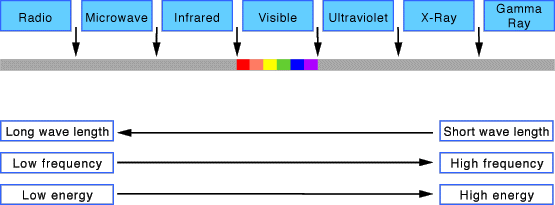Agents of Deterioration
Light
Potentially hazardous light sources are easy to identify since you can actually see them before measuring them. Obvious indications of light damage would be fading or deterioration of dyed fabrics, yellowing of paper, change in photo colors, loss of pigment, and yellowing of varnish on paintings, pastels, watercolors, etc. Understanding the properties of light can help collection caretakers reduce potentially harmful exposure.
Light is electromagnetic radiation that produces heat energy and can therefore catalyze chemical reactions. Natural light is made up of both visible and invisible spectrums. Light should be thought of as a continuous spectrum of energy that is divided into three categories. Here is a diagram of the electromagnetic spectrum that illustrates the wavelength, frequency, and energy level.
 xvi
xvi
Ultraviolet light
The shortest, most energetic form of electromagnetic radiation. High energy causes significant alteration and cellular deterioration of organic material. Ultraviolet radiation must be completely eliminated.
Visible light
Rich in blue radiation and has the most potential for damage. Sunlight and full-spectrum fluorescent light contain high levels of blue radiation. Warm fluorescent light is less damaging than cool fluorescent light because of the elevated amounts of red radiation. Incandescent light sources have the least amount of blue light and are a safer source of artificial illumination.
Infrared light
Lower frequency radiation that is invisible. Infrared radiation causes damage by elevating the surface temperature of the object, catalyzing chemical reactions that cause instability and deterioration. Natural and incandescent light have large amounts of infrared energy in them.
Both natural and artificial light can cause damage. Direct sunlight should be avoided since it contains high levels of infrared and ultraviolet radiation. "UV filtered natural light can cause more than five times the amount of damage of an equivalent visible level of incandescent light."xvii Windows and other sources for long term exposure to direct sunlight can be masked with tinted solar-reduction film, blinds, curtains and awnings.
Light damage is cumulative and irreversible. The key to light management is to use light efficiently. Reduction in ultraviolet exposure and locating incandescent sources safe distance from sensitive objects will reduce potential damage. Controlling light damage is based on time-duration and type of light exposure, sometimes referred to as foot-candle hours. Light is measured in foot-candles and the metric equivalent the lux. One foot-candle is approximately 10 lux. the more sensitive to light an object is, the less time the object should be exposed or on display. Keep lights dimmed or turned off in storage areas. Fragile materials used for display should be rotated frequently with no more than two months of continual exposure.
Downloadable chart of materials susceptible to ultraviolet damage and safe lighting limits.